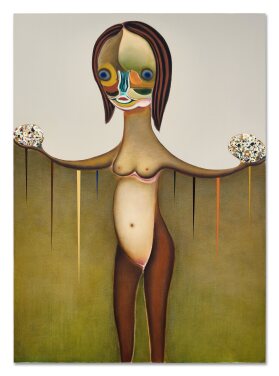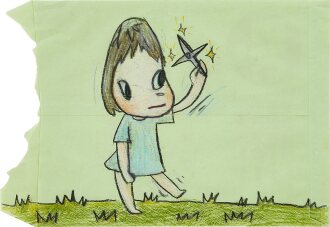T he art market in East Asia continues to gain momentum. Hot on the heels of the inaugural edition of Frieze Seoul, major new art fairs are slated to open in 2023 in Singapore and Tokyo with ART SG (12 to 15 January 2023) and Tokyo Gendai (6 to 9 July 2023), respectively. The renewed dynamism in Japan’s domestic market has been further bolstered by initiatives such as Art Week Tokyo, which will bring the capital’s museums and galleries together for its second edition this November. This revitalisation at home builds on the monumental stature of Modern and Contemporary Japanese art internationally, both in museums and the market. Here we highlight four hugely influential artists – Kazuo Shiraga, Yayoi Kusama, Takashi Murakami and Yoshimoto Nara – whose works have come to define contemporary Japanese art and popular culture on the world stage. Discover the works by these icons of Japanese art to be offered in Sotheby’s Hong Kong sales of Contemporary Art this autumn.
Kazuo Shiraga
"I want to paint as though rushing around a battlefield, exerting myself to collapse from exhaustion.”
Kazuo Shiraga, known for his powerful abstract canvases, was a pivotal member of the avant-garde art collective The Gutai Art Association. Emerging in post-war Japan, Gutai artists rejected staid traditions in favour of bold, performative expression and the pioneering of experimental techniques. Shiraga’s highly unconventional – and dramatic – technique included applying paint with his feet while swinging on a rope hung from the ceiling of his atelier.

Ferocious, provocatively primal, yet charged with exhilarating grace, BB85 is an exceptional work from the artist’s critical early period, known for its explosive dynamism and iconic colour palette. Writhing with fiery vigour, the present work is marked by “Crimson Lake”, Kazuo’s favourite vivid burgundy shade punctuated by a whirl of electric cerulean blue and splashes of inky black.

Executed in 1973, the swirling scarlet flames in Dattan (Shuni-e no gyo) threaten to leap from the canvas and engulf the viewer. Dattan (Shuni-e no gyo) was created during Shiraga’s early post-Gutai years of the 1970s; a period during which he received extensive training as a Buddhist monk. This experience engendered a heightened consciousness within his gestural art, granting his paintings a sense of transcendental enlightenment.

Rich in swirls of colour, from his iconic crimson to black, yellow, white, black and more, Untitled is an exemplary example of Shiraga’s physically exacting practice. Holding a rope to maintain his balance, Shiraga would step barefoot into various pools of paint he had poured onto the canvas, twisting and swinging, pulling the paint into arcs using his feet.
Yayoi Kusama
Revered across the world for her immersive mirrored installations, intricate paintings and dotted pumpkins, Yayoi Kusama ranks among the most influential living artists working today. Kusama first came to prominence as part of the artistic avant-garde of 1960s New York; participating in Happenings and Pop performances. Kusama has described her work as a form of self-therapy to free herself from her psychic obsession. “I fight pain, anxiety, and fear every day,” she writes in her autobiography. “And the only method I have found that relieves my illness is to keep creating art.”
This November, Hong Kong’s M+ will open Yayoi Kusama: 1945 to Now, the largest retrospective of the artist ever staged in Asia outside Japan.

Dancing with rhythmic motion, Infinity-Nets (QPOW), continues the legacy of a series begun by the artist in 1958. Created almost 50 years later, this 2006 work recalls those earliest iterations in its textured white, monochromatic surface. Kusama struggled with visions of infinitely oscillating, kaleidoscopic patterns throughout her childhood. In part, the remarkable Infinity Nets series can be seen as both a manifestation of, and coping mechanism for, this condition.

"Just as Bodhidharma spent ten years facing a stone wall, I spent as much as a month facing a single pumpkin. I regretted even having to take time to sleep.”
Kusama’s pumpkins serve as a representation of stability and comfort in the artist’s tumultuous life. The initial manifestation of the motif can be traced back to the late 1940s, in the artist’s Nihonga practice at the Kyoto Municipal School of Arts and Crafts, while the pumpkin itself is central to the psyche of the artist, stemming from a vivid hallucination in her childhood. “The first time I ever saw a pumpkin was when I was in elementary school and went with my grandfather to visit a big seed-harvesting ground,” Kusama has said. “And there it was: a pumpkin the size of a man’s head… It immediately began speaking to me in a most animated manner.”

Pumpkin is the rare original painting of a much sought-after series of prints that was released that same year. Resplendent with dots and lines that seem to dance on the canvas, the visual mania of Pumpkin invites us to lose ourselves in the vastness of Kusama’s singular universe. It is a meticulous representation of Kusama’s enduring visual language.
Takashi Murakami
Takashi Murakami’s "Superflat" style combines elements drawn from anime, Nihonga painting, and Pop Art. Bringing together fine art and pop cultural references, while combining fantasy, science and history, Murakami’s Superflat world is populated by smiling flowers, jellyfish eyes, and his own alter ego, Mr. DOB.

The series of 727 works are considered among the artist’s most iconic works. In this present work, Murakami’s iconic protagonist, the anime-inspired character Mr. DOB, emerges from a cresting wave; the stylised surf echoing Hokusai’s 1831 woodblock The Great Wave off Kanagawa. In contrast to the bright, almost lurid colours of Mr. DOB, the background – layered in drips, with the appearance of a graffitied back street – gives the work an almost dystopian feel.

A collaborative work created with Virgil Abloh (1980–2021) who rose to prominence as the artistic director for Louis Vuitton’s menswear, Times Nature is a funky mash-up of their respective styles and trademarks – here centred by Murakami’s iconic smiling flower motif.
Yoshitomo Nara
Yoshitomo Nara has developed a cult following across the world for his paintings of sullen children and animals that address themes of adolescence and angst. Nara plays with apparent innocence of these wide-eyed characters, sometimes depicting them with sinister expressions or objects such as a knife.
“Nara’s roly-poly children balance on the razor’s edge: they are cute embodiments of infantilism in their chubby-cheeked plumpness […] but at the same time true individuals who will not be defeated, quiet carriers of hope.”

Inspired by the shape of a pumpkin and a cream puff, Nara’s Puff Marshies embody the arresting sentiment of childhood through the rosy-cheeked, button-nosed, kawaii girl filled with sweetness, yet her eyes betray nothing; no thoughts, no suggestions. We are left bewitched and bewildered by the dreamlike chaos that is precisely emblematic of Nara’s oeuvre.

In the Floating World (Set of 16) captures Nara’s ability to be playful and bring a fresh perspective to traditional motifs and aesthetics. Reworking the woodblock prints, Nara appropriates the classical imagery of the ukiyo-e prints, adding in his iconic protagonists. While some are humourous, others pertain to a more critical social comment.









